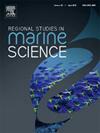Biological traits and functional diversity of free-living nematode assemblages along a water-depth gradient in the northwestern of Gulf of Mexico
IF 2.4
4区 环境科学与生态学
Q3 ECOLOGY
引用次数: 0
Abstract
This study analyzed the biological traits (BTs) and functional diversity (FD) of free-living nematodes in the northwestern of Gulf of Mexico. We collected sediment samples at 27 sites at a depth gradient from 44 to 3466 m. The nematodes were identified at species level and classified in five groups of BTs: feeding type, amphid shape, tail shape, body shape, and body length. We determined the FD based on the combination of BTs through a functional dendrogram, using the total length of the branch as a measure of functional diversity. Salinity, pH, and dissolved oxygen were measured in each site, as well as the sediment composition and percentage of organic carbon (OC). A total of 1673 nematodes were identified, belonging to 35 families, 96 genera, and 153 species. The number of species varied along water depth (1–60 species). The more abundant BTs were the non-selective deposit feeders (49 %), amphid spiral shape (55 %), clavate conical cylindrical tail (52 %), sizes 1000–1500 μm (51 %), and body shape slender (97 %). The most common combination of traits was non-selective deposit feeders, spiral amphid, clavate conical cylindrical tail, slender shape, and sizes < 1500 μm. The changes of BTs with increasing depth were more evident in the feeding types and amphid shape. The FD fluctuated between sites (0.42–0.99) and was significantly correlated with the number of species, suggesting that taxonomic and functional diversity have similar responses to environmental variables. The FD was significantly influenced only by the percentage of sands. Our data provide valuable information that can be used in subsequent studies and benthos monitoring.
墨西哥湾西北部沿水深梯度的自由生活线虫群落的生物特征和功能多样性
本研究分析了墨西哥湾西北部自由生活线虫的生物特征(BTs)和功能多样性(FD)。我们在深度梯度从 44 米到 3466 米的 27 个地点采集了沉积物样本。我们对线虫进行了物种鉴定,并将其分为五组 BT:摄食类型、两栖动物形状、尾部形状、体形和体长。我们通过功能树枝图确定了基于 BTs 组合的 FD,使用分支总长度作为功能多样性的衡量标准。我们测量了每个地点的盐度、pH 值和溶解氧,以及沉积物成分和有机碳(OC)百分比。共鉴定出 1673 种线虫,隶属于 35 科、96 属和 153 种。物种数量随水深而变化(1-60 种)。数量较多的 BT 为非选择性沉积摄食者(49%)、两栖螺旋形(55%)、棍棒状圆锥圆柱尾(52%)、大小 1000-1500 μm(51%)和体形细长(97%)。最常见的性状组合是非选择性沉积摄食者、螺旋状两栖类、棍棒状圆锥形尾、体形细长、体长为 < 1500 μm。随着深度的增加,BTs 的变化在取食类型和两栖类形状上更为明显。FD在不同地点之间波动(0.42-0.99),并与物种数量显著相关,表明分类和功能多样性对环境变量的反应相似。只有沙的百分比对 FD 有明显影响。我们的数据提供了宝贵的信息,可用于后续研究和底栖动物监测。
本文章由计算机程序翻译,如有差异,请以英文原文为准。
求助全文
约1分钟内获得全文
求助全文
来源期刊

Regional Studies in Marine Science
Agricultural and Biological Sciences-Ecology, Evolution, Behavior and Systematics
CiteScore
3.90
自引率
4.80%
发文量
336
审稿时长
69 days
期刊介绍:
REGIONAL STUDIES IN MARINE SCIENCE will publish scientifically sound papers on regional aspects of maritime and marine resources in estuaries, coastal zones, continental shelf, the seas and oceans.
 求助内容:
求助内容: 应助结果提醒方式:
应助结果提醒方式:


